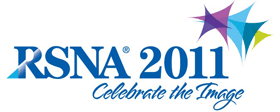
Abstract Archives of the RSNA, 2011
Fernando Garcia Garcia MD, PhD, Presenter: Nothing to Disclose
Jaime de Miguel Criado MD, Abstract Co-Author: Nothing to Disclose
Carmen Garcia Roch MD, Abstract Co-Author: Nothing to Disclose
Jose Hernanz Padial, Abstract Co-Author: Nothing to Disclose
Miguel Pastrana MD, Abstract Co-Author: Nothing to Disclose
Jose Segura Crespo, Abstract Co-Author: Nothing to Disclose
To evaluate the effectiveness of the iPad 2 and the iPhone 4 for assessing acute ischemic stroke on CT, comparing them to commercial-grade PACS LCDs.
We selected a total of 149 patients: 74 acute stroke cases (confirmed on MRI) and 75 negative cases (confirmed on follow-up/MRI). All patients underwent head CT for suspected acute stroke. The original reports by a Neuroradiologist attending on a PACS workstation of the CT images were used as the gold standard. All datasets were wirelessly imported in DICOM format on an iPad 2 32GB and an iPhone 4 32GB (Apple Inc) running the OsiriX HD iPad/iPhone app version 2.0.
The 149 examinations were provided to two general radiologists for determining the presence or absence of acute stroke. The 1st radiologist reviewed the iPad 2 images and then examined them on the iPhone 4 three days later to reduce recall bias. The 2nd Observer analyzed the images first on the iPhone 4 and then on the iPad with the same delay. We calculated sensitivity and specificity for each display and each viewer, and the interobserver agreement.
The original CT interpretation on PACS LCD was positive in 44 of 74 patients with acute stroke (Sensitivity[S] = 59,5%; 47,5-70,7% p<0,05). First viewer diagnosed acute stroke in the same 44 patients than original CT reports on both the iPad2 and the iPhone 4 (S=59,5%; 47,5-70,7% p<0,05). Second Observer diagnosed 45 positive cases (S=60,8%; 48,8-71,2% p<0,05).
Interobserver agreement for detection of acute stroke was very good (Kappa: 0,98; 0,95-1 p<0,05).
There were no false-negative assessments in the whole study neither on PACS LCD nor both iPad 2 and IPhone 4. (Specificity= 100%; 95,2%-100% p<0,05).
Subjectively, both radiologists felt that the iPad’s display and its software was good for acute stroke diagnosis. They also argued that iPhone’s display contrast was better but its size was too small.
Our results suggest that both the iPad 2 and the iPhone 4 demonstrate equal or even better sensitivity with the same specificity than commercial PACS displays on the diagnose of acute stroke on CT. Additional studies may be required to validate these devices as portable diagnostic tools for assessing acute stroke.
In our study IPad 2 and iPhone 4 equal sensitivity and specificity of PACS LCDs for the diagnosis of acute stroke, and may be suitable as portable diagnostic tools for its screening on CT imaging.
Garcia Garcia, F,
de Miguel Criado, J,
Roch, C,
Hernanz Padial, J,
Pastrana, M,
Segura Crespo, J,
iPad 2 and iPhone 4: Is It Feasible to Assess Acute Stroke Using an Apple Mobile Device?. Radiological Society of North America 2011 Scientific Assembly and Annual Meeting, November 26 - December 2, 2011 ,Chicago IL.
http://archive.rsna.org/2011/11012041.html

